Editor’s Note: This story was originally published in the Winter Issue of Life & Thyme’s print magazine.
——
Near the entrance of a bakery in New York City’s West Village, I’m sitting on sidewalk sucking on strips of yuzu sake pâte de fruits, successively freeing one after another from what looks like a repurposed tuna fish tin. The chewy, sweet and sour straps are so addictive, I’m too busy with them to notice all I can talk about are the dime store sour candy belts I used to buy with my allowance when my mom dropped me off at the mall. The blue raspberry and green apple of my youth may not have been quite so sophisticated as the flavor I have here, but it’s hard to deny they’re not-so-distant relatives.
I pass the tin, trading it for a plate of beignets on the table. The fried purses are pillowy and warm, and they remind me of the pizza frites that my grandmother made when I was a kid––except instead of a layer of powdered sugar melting into the residual oil, it’s a fabric of green granules: matcha powder.
And it goes on like this, everything in front of us is at once familiar and yet totally unlike anything we’ve had before.
Although the techniques are strongly based in the traditional––the doughs, the choux pastries, the tart shells––there’s a throughline of playfulness and ingenuity. Recognizable methods have been recast into updated roles––departures from any classic French pastry shop, where products like these are a serious business certainly not to be messed with. For Americans, that’s a mentality curiously contradictory to the whimsical, childlike associations with sugar and sweets.
Over mouthfuls of a precariously piled “extra fluff mille feuille”—one that is, oh, roughly the size of my head—and a lusciously creamy lemon yuzu butter tart, we discuss desserts that are distinctly rooted in Americana, and what this bakery has done in its short life to upend decades of stateside classics. Chocolate chip cookies turned into drinking vessels for milk, s’mores served with a frozen hunk of vanilla ice cream hiding within. And of course, a creation that is composite of American and French culture so famous that it called for its own trademark. The man responsible has repeatedly been called the closest thing we have to a real life Willy Wonka. Surely he’s some wild eccentric. Probably at least a little odd … right?
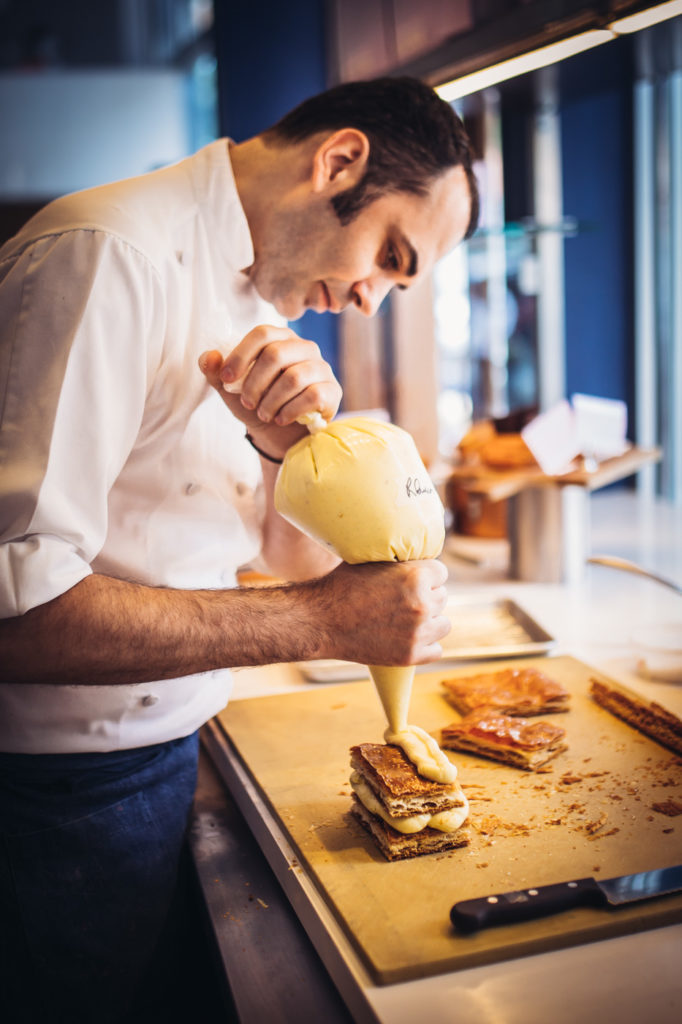
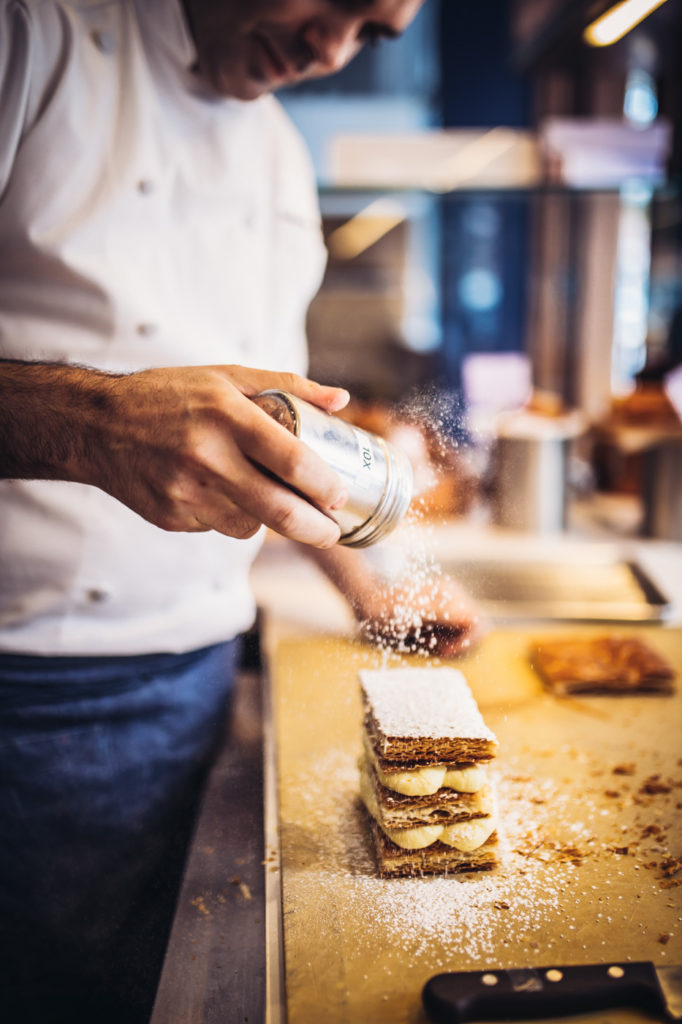
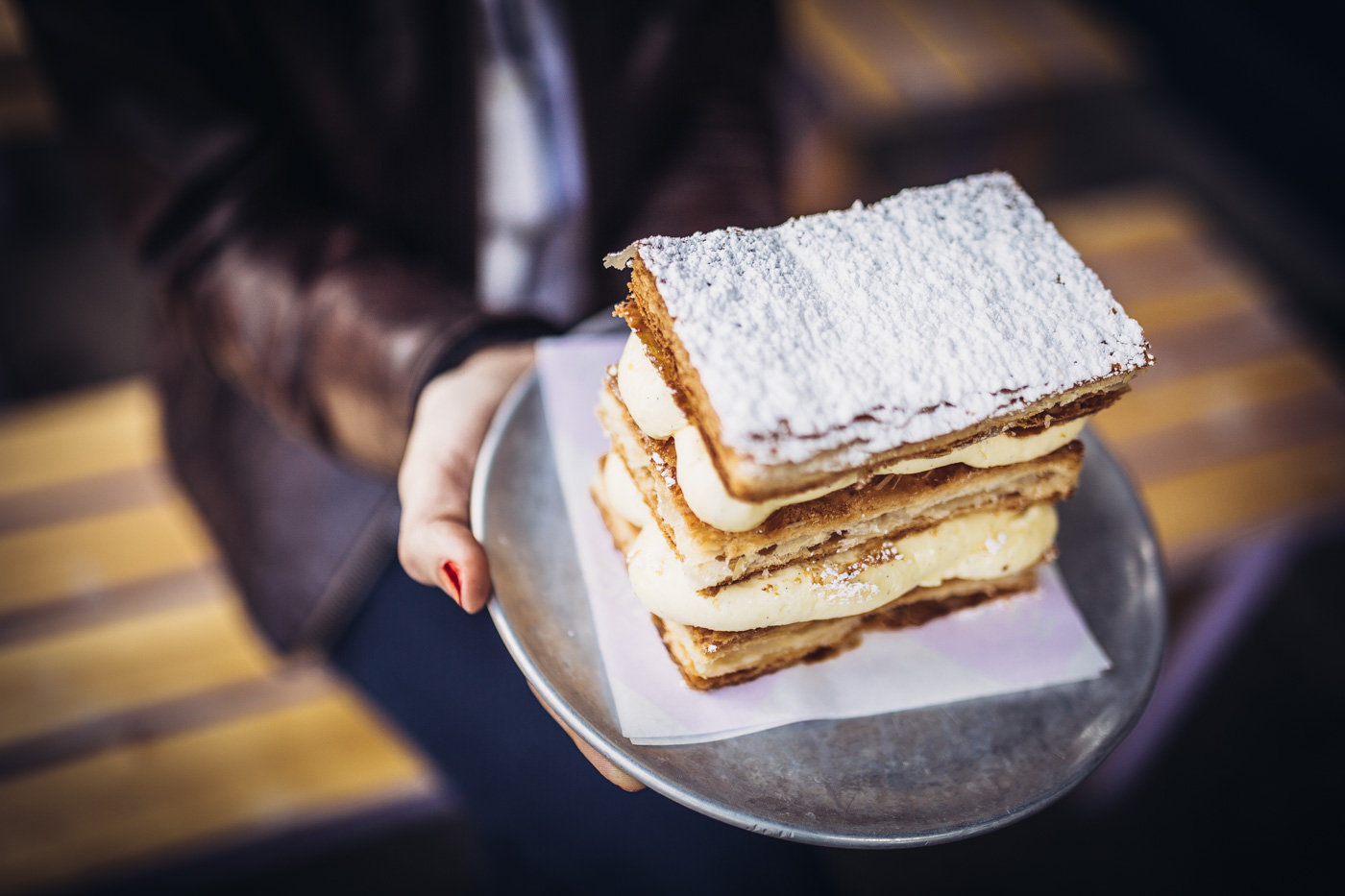
——
“Do you know about the frozen s’more?” Dominique Ansel asks me.
I don’t. Not really, anyway––not beyond the practically pornographic cross-section posts that pepper an Instagram grid when searching #dominiqueansel.
Sitting with Ansel today, a single word keeps spinning in my mind: simpatico. Maybe it’s the darkness of his features––his deep set eyes, nearly coal black hair threaded through with a few well-earned grays––they’re warming, understanding. And despite a daily schedule that begins with a 5 or 6 a.m. arrival at his bakery, he hardly stops smiling. He never seems bored or distracted, never allows a guest to exit without thanking them, never checks his watch or appears to disengage. He’s sensitive to my time, to my comfort, and enjoyment of his space. He’s made sure I’ve been welcomed with hot coffee and a freshly baked pile of chocolate madeleines.
In fact, the man sitting with me in the sunny storefront is quite at odds with the aloof and top-hatted, backwards speaking savant I’d prepared myself for. This guy seems totally normal––he’s relatable, approachable, and doesn’t appear to own any panic-inducing, time-traveling tug boats. He simply is––simpatico.
Ansel goes on, too enthusiastic to wait for a proper answer, “It’s a cube of vanilla ice cream coated with a chocolate wafer pushed inside a honey marshmallow. We serve it on a willow wood branch that’s been smoked, so it smells like campfire, and we torch the marshmallow to order. When you bite into it, you have this super-thin crust, and it’s cold and crunchy. It’s… emotion.”
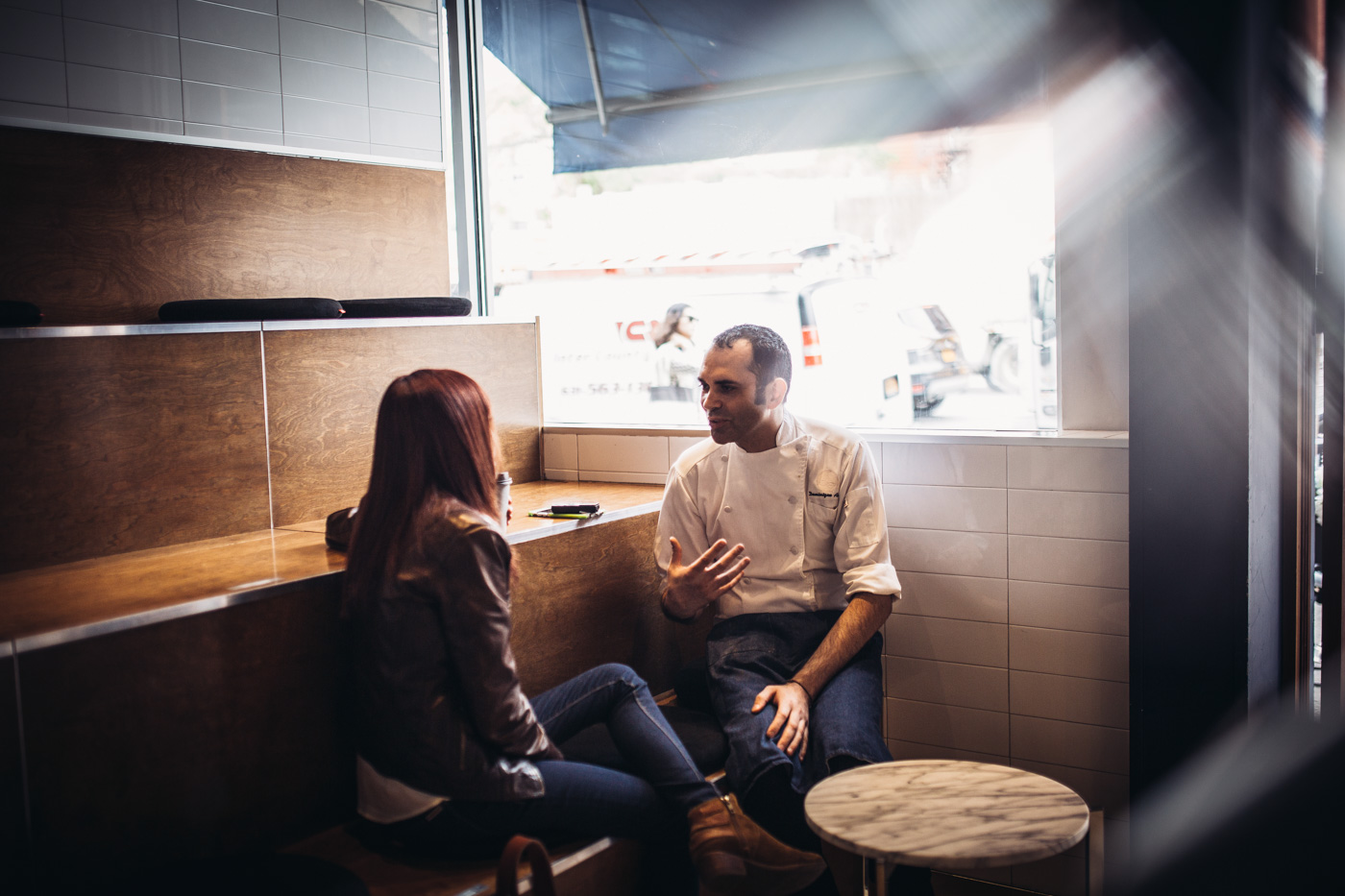


Although the chef is elucidating through an accent that lingers from his French upbringing, I have no problem understanding what he’s saying. Because here in the States, we have a phrase for what he’s describing. We call it, “eating your feelings,” and it’s practically a national pastime.
And it is with feeling––one of discovery––that Ansel describes his relationship to the s’more. “In America, people grow up eating s’mores. I did not, but I’ve learned about it here,” he says.
It’s in his curiosity to learn such things, his unfamiliarity with what many of us take for granted, that lies the crux of his edge. Where other s’more (or similarly nostalgic) reboots come off tired and contrived, Ansel’s has novel energy. He’s learned anew what we seem to have forgotten; that it isn’t just about the marriage of marshmallow, chocolate and graham cracker. The treat’s endearment to us is in large part owed to the experience of its assembly and the engagement of multiple senses––the aroma of charred wood, the slight crisp of the toasted marshmallow. To simply reincarnate with its basic components is to overlook a critical ingredient––the emotions. There are those feelings again.
It seems simple enough, although sometimes eating at an Ansel establishment leaves you whacking your forehead, saying, “Why didn’t I think of that?” But the creativity often relies on his fresh perspective, one formed upon relocating from France to New York as an adult, less than 10 years ago when Daniel Boulud offered him a position at his eponymous restaurant.
“It helps just to step back. If I were to go back to France tomorrow and open a bakery, I would have a different approach. Because I’ve traveled, I see what people like and I know why they like it,” Ansel explains. “I thought to myself, ‘What would be a fun way for people to enjoy ice cream rather than in a cup or in a cone?’ Serving it on a branch would be fun. Making the ice cream version of a s’more would be even more fun.”
That word––“fun”––probably comes out of Ansel’s mouth more than most chefs, especially one with such a disciplined background. But he’s not in the business of burdening guests with an overblown emphasis on technique––he’s not interested in elevating once-favorite foods beyond their reach. And he didn’t ask, “How can I make a s’more better?” or even more technically sound. He simply asked how it could be more fun.
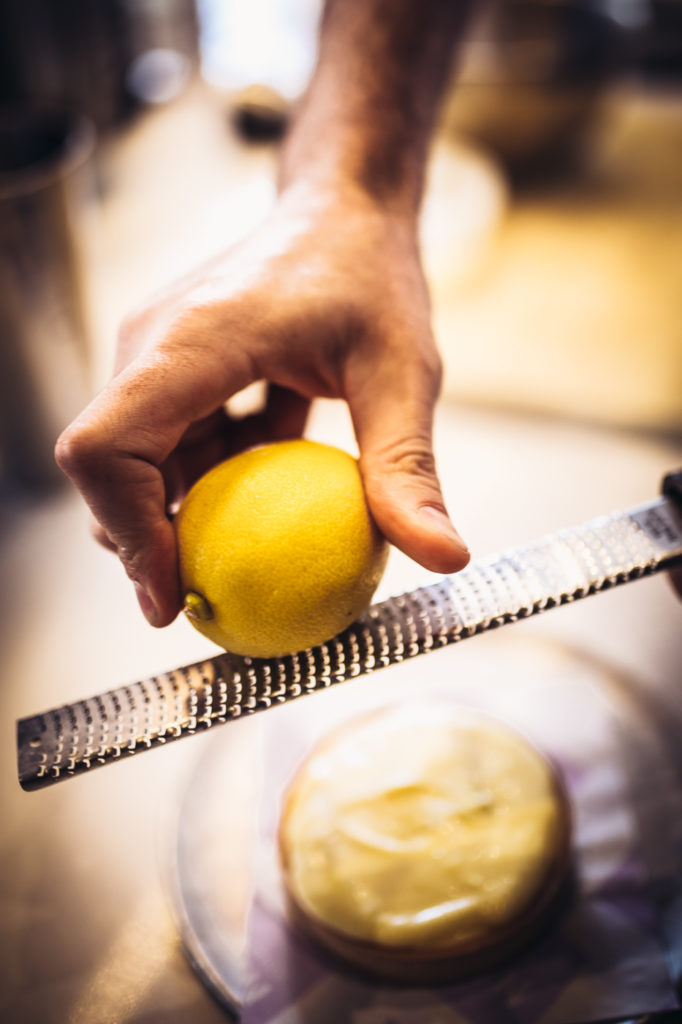
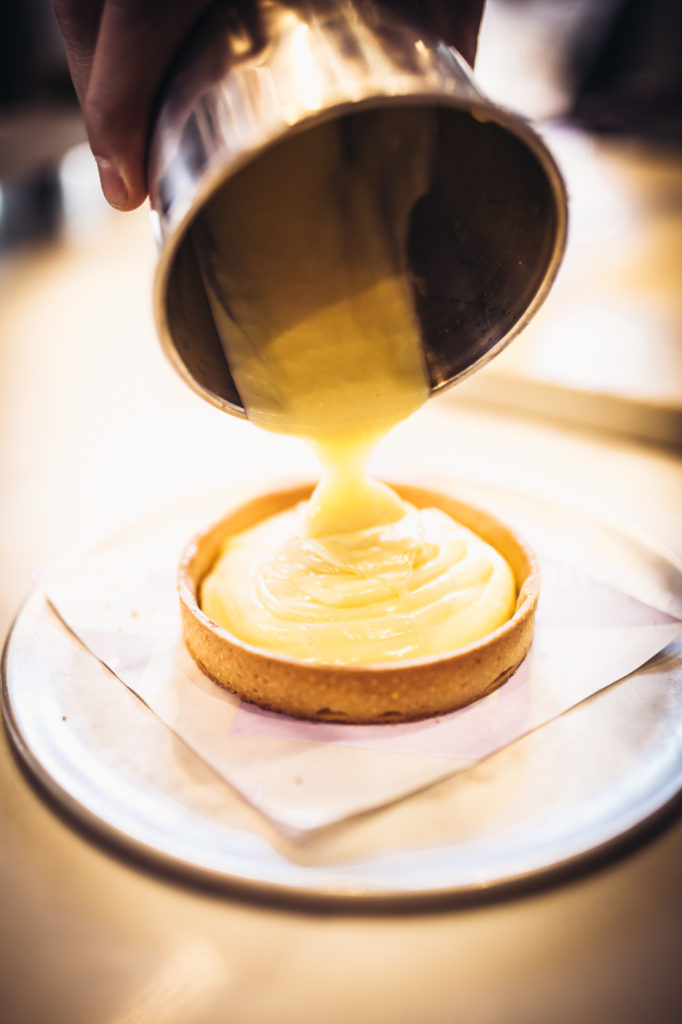
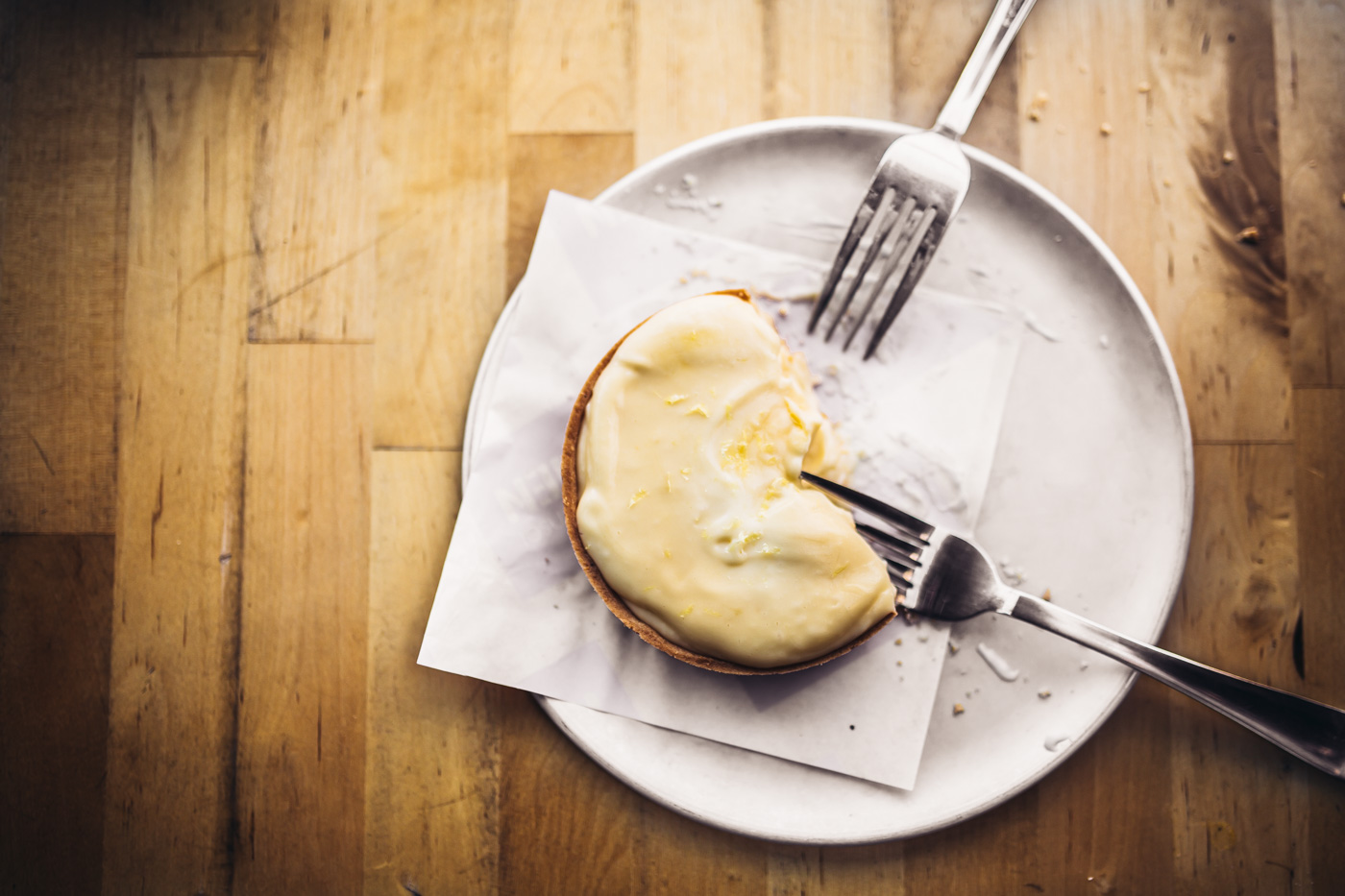
“The cookie shot, for example, is something so simple. I didn’t grow up drinking milk and eating cookies; that’s something I’ve discovered here. I said to myself, ‘What would be a fun way for people to drink milk and eat cookies?’ Put the milk in the cookie.”
Being without preconception allows Ansel to take an almost youthful approach; he can be a student of culture––not only American, but global. There’s the sense that he could just as easily be a professor of psychology as a pastry chef. He observes and then leverages sound technique to reimagine regional favorites that he finds in his travels like an epicurean anthropologist.
“I’ve traveled a bit, and I always got super excited about learning different cultures, different styles of cuisines, learning how people eat, why they eat it, when they eat it. Every country––every town––has a specific dish they eat at a certain time of the year, or that’s traditional or that has a very special ingredient you can only get for a certain season. I always had a super open mind and wanted to learn from people and grow as a chef and as a person,” Ansel says. “I’m very curious; I think that’s very important for creativity. To not only focus on what you’re doing, but to also look around. There are many people who are talented, who are special––and they all do things for a reason.”
Ansel allows himself to maintain a sense of awe, and he appreciates his surroundings now as much as he did when he arrived on Boulud’s doorstep almost 10 years ago––if not more.
“I love New York. This is my town. This is home. [I knew] that the first day I came here. I love this city. There’s this energy in New York. It’s…” he pauses, searching for the words. “I don’t know, it’s exciting! People are so open-minded. They’re friendly––New Yorkers are friendly, yes! There’s such a mix of ethnicity, so much to learn about different cultures, about different foods. It’s a city of so much talent––chefs, artists, painters––people who are specializing in their industry, who are elite, who are at the top. New York: it is the city that has the energy of America.”
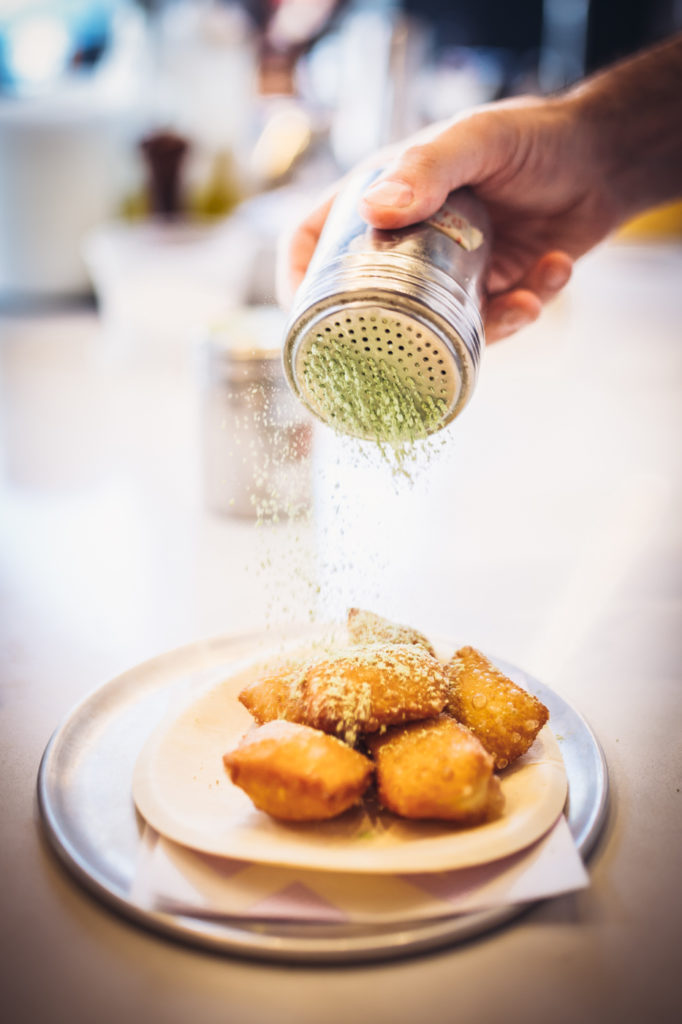
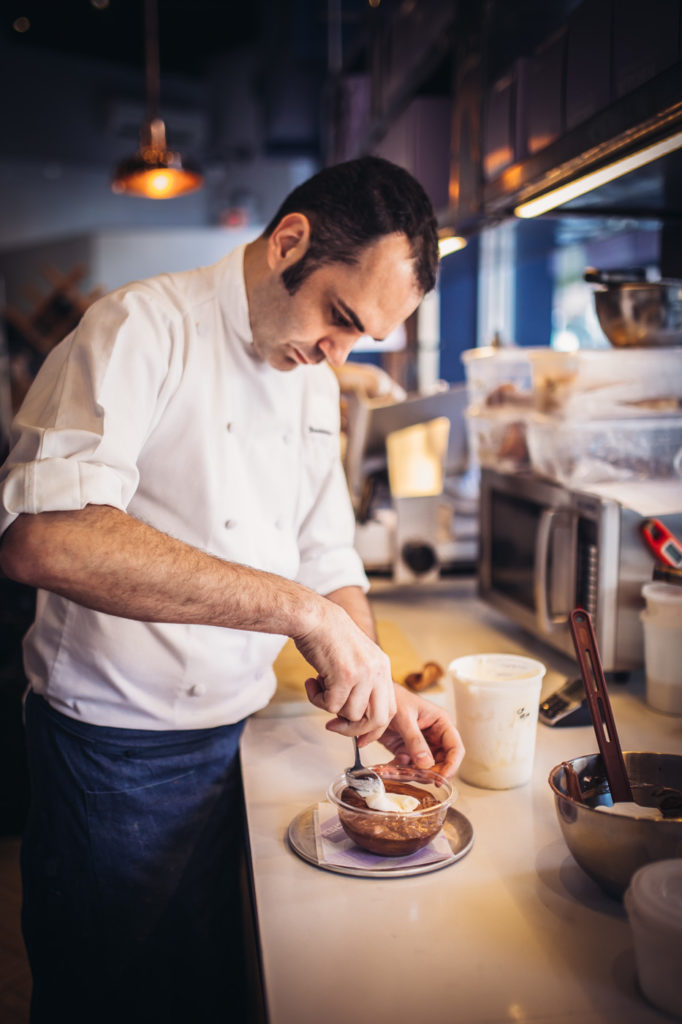
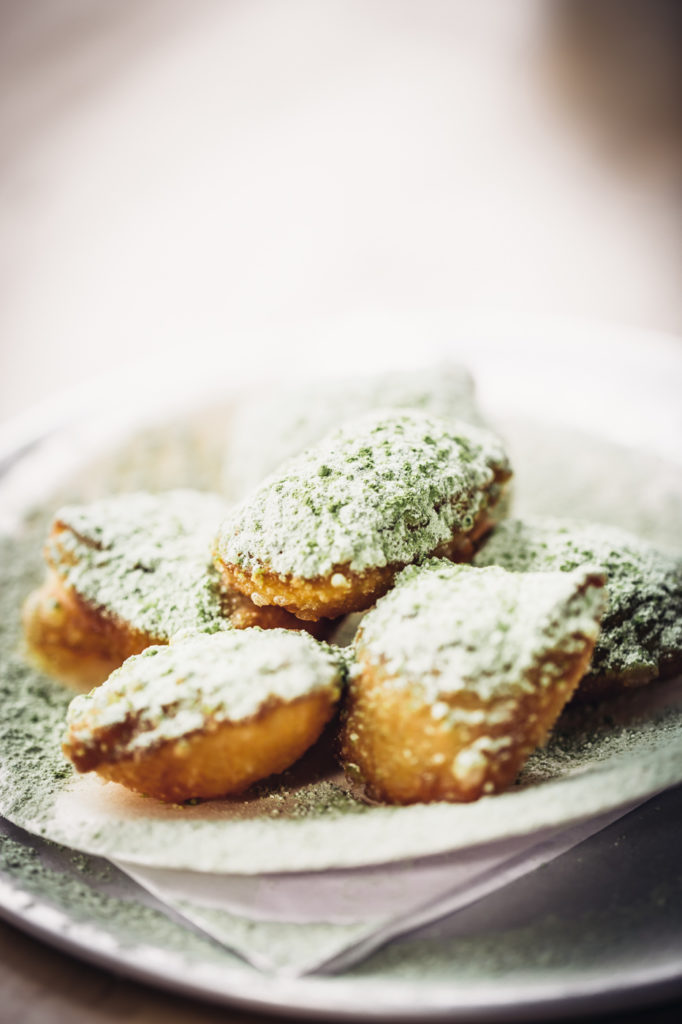

And so it felt natural to him to open his business here, rather than return to Europe. Ansel’s initial location, Dominique Ansel Bakery, opened on Spring Street in Soho in 2011. Since then, he’s added Dominique Ansel Kitchen (the sunny, hip West Village setting for our meeting), as well as a version of the bakery in Tokyo and London. Back in New York, the chef launched U.P., or Unlimited Possibilities, a full-scale plated dining experience that offers a tasting menu entirely of dessert courses (Count. Me. In.).
These headline-ready endeavors have earned Ansel a reputation for having a theatrical streak. Perhaps no more evidenced than at U.P., where the meal is served on a table lowered from the ceiling into the center of the kitchen where a scant eight chairs await––in each a diner having competed for a coveted (and ticketed) spot among 48 for the entire week. Three nights, two seatings each. The end.
At U.P., Ansel doesn’t dwell so much on the spectacle but rather the relationship it allows him to have with diners. “[U.P.] is about about telling a story from beginning to end. It’s very intimate. It’s about the emotions and memories through food and connecting with people.”
Ansel suggests that in the expanse of multi-course tasting menus in today’s dining scene, it’s difficult to find dishes that are memorable. “This menu is designed so you remember all of the dishes, or at least almost all of them,” Ansel explains.
By acknowledging the correlation between a personal experience and the creation of a memory, Ansel and his team cleverly lean on memories already indelible to their guests. The idea is that in simply assigning a dish to existing and universally unforgettable milestones, they ensure more durable, lasting impressions.
The first concept menu at U.P. upon its opening was “First Story.” Ansel explains, “It retraces all the first times of someone’s life; from your first word, to your first kiss, to your first time living on your own, to your first heartbreak––it’s eight beautiful dishes. They’re very interactive, very playful. And they have an emotional connection for people,” Ansel continues. “Everyone remembers their first word, their first time living on their own, their first kiss, their first heartbreak––and all of the dishes have to do with something personal. It makes people think and remember.”
And how, exactly, does one represent these momentous occasions through plated desserts? First word is composed of sweet pea, rice milk, gin, carrot cake and yogurt meringue. First kiss? Raspberry, roasted peanut water, cream soda pearls and fresh mint. Each with essences common to the respective occasions.
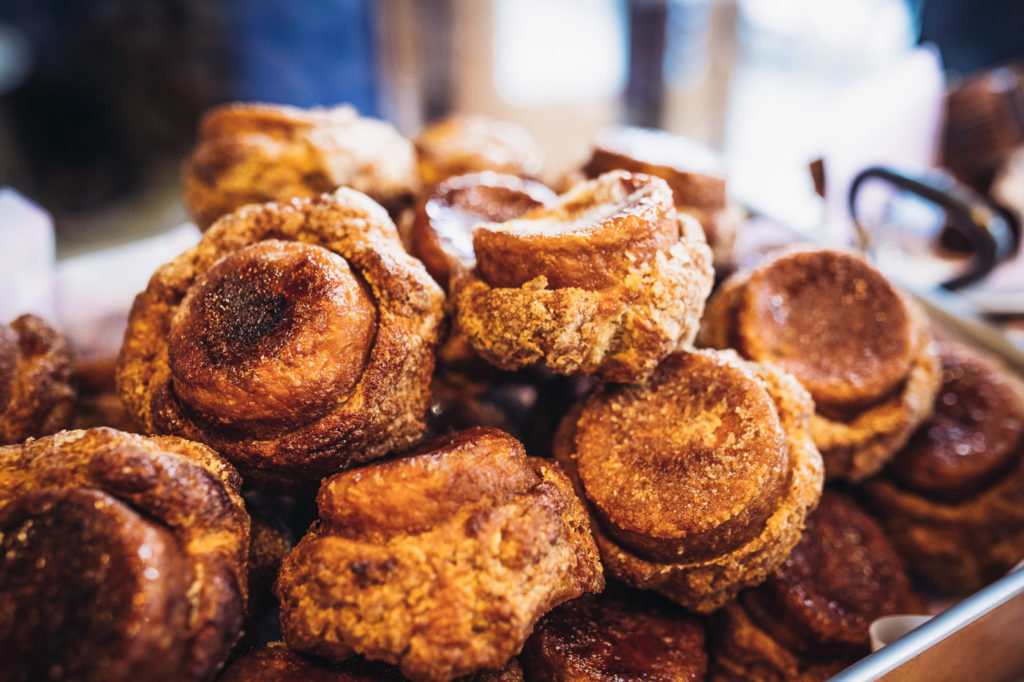

It’s no wonder people expect the man behind the Cronut curtain to be in possession of a bombastic personality. But in reality, the soft-spoken Ansel is as concerned about community and quality as he is about putting on a good show.
In fact, despite comparisons to Gene Wilder’s iconic candy man, he wants no part of any such factory mentality. “I don’t want to be a Cronut factory,” he tells me of his decision not to mass-produce the pastry––the one that famously launched dozens of other Franken-fections (see also: Cruffin, Bonut), and has shown up in iterations everywhere from Dunkin Donuts to Disney World. “In the beginning people were telling me to sell out, to put it in the supermarket and every corner of the world. It’s not something I believe in. It would just be destroying our creation, killing our creativity. And we’ll never have a chance to raise money for charity, for example.”
Having once auctioned off 24 Cronuts for over $100,000, it’s easy to see that keeping the original Cronut a commodity can be valuable in more ways than one. Focused philanthropic projects are also of personal significance to the chef, particularly those that target hunger. “It’s something I care for––something I lived when I was younger. My father had only a small salary; at the end of each month, it was kind of rough. In a place like New York City, there’s so much wealth. We shouldn’t forget there are also people who are hungry, people who need help.”
While he won’t supply a mass market with the actual pastries, he’s more than happy to turn over the instructions (a philosophy supported by his first cookbook, Dominique Ansel: The Secret Recipes). “We should share. There’s no way a chef can hide in a corner because they don’t want their staff to see [a recipe]––they’ve seen it! If you find a good use in your life for [the recipe], please share it. We’re in a new world. It’s time to move forward, to be better people.”
“The team for me is everything,” Ansel continues. “One person––one chef––is nothing without a team. They are the people who run the kitchen every day, who touch the food, who welcome you, who tell you the story behind each dish. We develop a culture where they are passionate. They learn, they become stronger––and hopefully someday they go on to do their own thing, and they take as much as they can from us.”


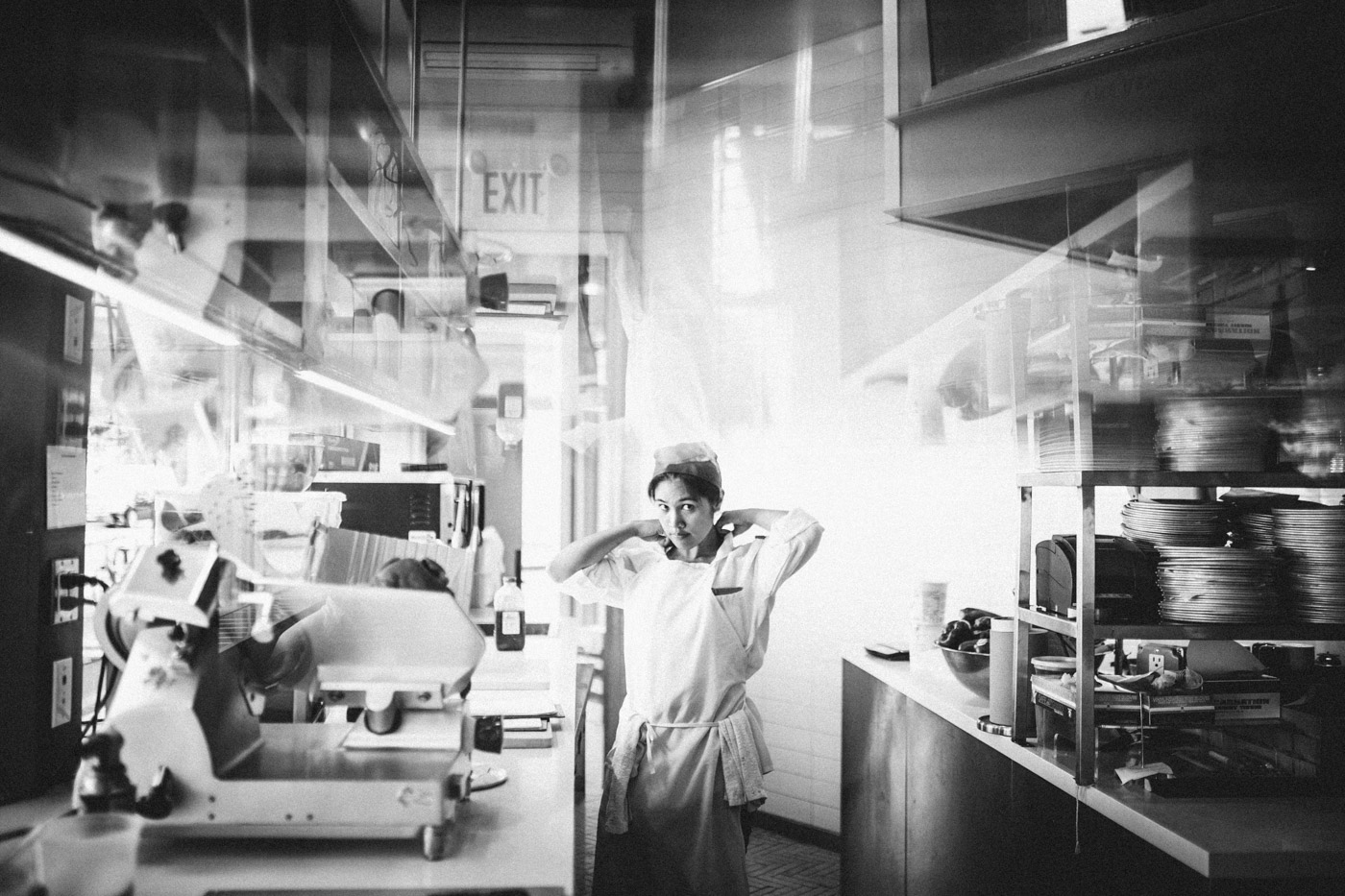
It’s a liberal vantage point that decamps from the kitchens of his early professional years, but Ansel feels it’s one that is becoming more common in today’s culinary vista. “There’s a new generation of chefs, of bakeries, of businesses. I’ve learned there is a positive way. I was told to be quiet and produce––just make it, and make it fast. I don’t believe in [that]. I believe you should give someone a recipe and teach them everything you know about it––so they avoid mistakes, so they grow with you, so they can teach the staff under them. That’s how you grow a team; you make everyone very strong.”
And whether as a businessman or an innovating chef, Ansel’s own strength is in his observational nature, his sensitivity to and understanding of people and connections––in being simpatico.
He doesn’t recreate for the sake of ego, of putting his personal stamp on something. People return––and return, and return––not only because his confections are, in fact, delicious, but because he understands and retains the essence of why we loved something in the first place. They’re based in insights that allow him to reinvent his world, both in and out of the kitchen.
And yes, Ansel understands the complex reactions behind pastry science, he has decades worth of world-class technical skill. But let’s be honest, there are plenty of damn fine croissants in this city. What makes his different is feeling. “It’s emotion. This is how we recharge people. It’s not just food that you eat to feed yourself.” Bakery items and desserts are rarely sought out for sustenance. Rather, they’re items that are meant to enrich our lives, to be an indulgence––to be fun.
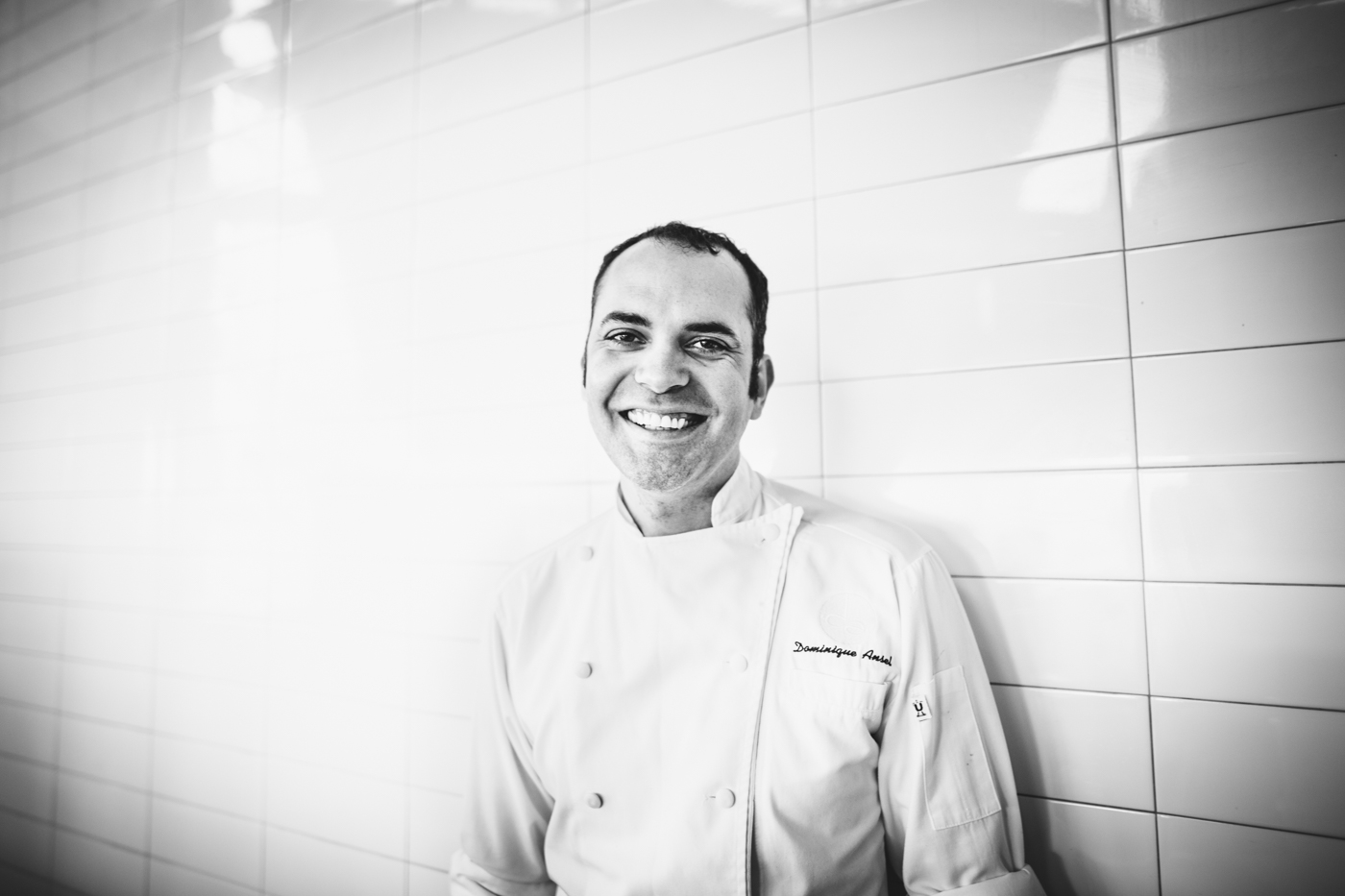
Ansel continues to comb the cultural catalogue of confections and pulls at will––nothing too low-brow, too unusual, nothing off the table. He approaches everything with a critical curiosity, and he gives us an excuse to sit as adults on a New York City sidewalk and be transported––to our pasts, to the future, around the country or around the world.
And while ingredients are important, and technique indispensable, enjoyment is about our memories and the experiences that are tied to those feelings. Because at the end of the day, all most of us really want is to eat our feelings.







Our comments section is for members only.
Join today to gain exclusive access.